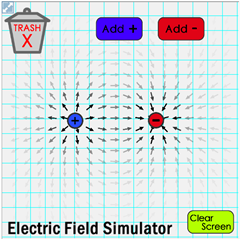 Electric Field Lines
Electric Field Lines
Resource:
Physics Interactives - Electric Field Lines
Student Activity - Electric Field Lines
Grade Level: High School
Description:
We can’t see an electric field. It helps if students have a tool to visualize electric field as a region of space in which point charges interact. Within this context, they can better understand the predictable patterns that occur in electric field lines. This activity, intended for the mid-to-latter stages of a learning cycle on electric force, lets students explore two charges along a line (the simplest way to start) or various configurations of charges in two dimensions. The accompanying Student Activity provides explicit guidance to help students form correct concepts about strength and direction of an electric field.
Performance Expectation:
Force and Motion (HS-PS2-4): Use mathematical representations of Newton’s Law of Gravitation and Coulomb’s Law to describe and predict the gravitational and electrostatic forces between objects. (Clarification statement: emphasis is on both quantitative and conceptual descriptions of gravitational and electric fields.)
This activity aligns with the three dimensions of the Next Generation Science Standards in the manner described below:
Physical Science: Force and Motion, Types of Interactions (HS-PS2.B.2):
Forces at a distance are explained by fields (gravitational, electric, and magnetic) permeating space that can transfer energy through space. |
In this activity, learners explore direction and strength of an electric field for a single charge or a configuration of several charges. Click buttons to add or delete positive and negative charges, drag the charges around, and pile them on top of each other……and watch what happens to the field lines. The Student Exercise challenges students to construct line diagrams for varying instances of two or more charges. |
| Patterns: Different patterns may be observed at each of the scales at which a system is studied and can provide evidence for causality in explanations of phenomena. |
Electric field lines are an example of an elegant and thoroughly predictable pattern in nature. As students manipulate the simulation, they will understand that electric field lines are directed away from positive charges and toward negative charges. By analyzing the field line patterns, learners build the foundation to do calculations related to electric force. |
Developing and Using Models
Use a model to provide mechanistic accounts of phenomena. |
Mechanistic models are very useful in physics because they seek to explain how a system functions through its individual components. They are often used in cases where empirical models based on direct observation would be impossible (such as a public school classroom). In this activity, students investigate how field line patterns are governed by the sign of charge (positive or negative), distance between charges, and quantity of charge. |
Associated Reading from The Physics Classroom
Other Supporting Pages at The Physics Classroom:
View Infographic.
(Coming Soon)
Search the NGSS Corner
Maybe you're looking for something really specific that pertains to a desired topic and emphasizes one or more of the listed NGSS dimensions. Why not try a search of this section of our website? Simply select from one or more of the pull-down menus and click Search. This page will reload and a collection of possibilities will be displayed in this section of the page and sorted by relevancy.